Выборка записей по тегу "2016"
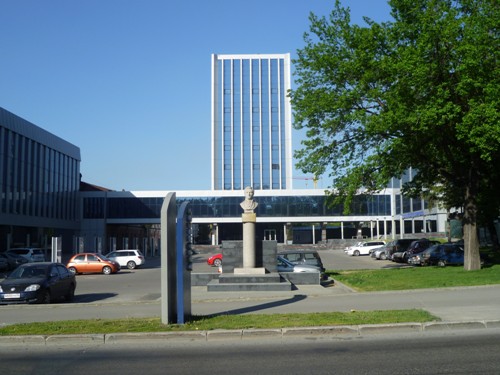
145. Реконструированное здание издательско-полиграфического предприятия "Алтай" и бюст П. К. Фролова / The reconstructed building of the publishing & polygraphic enterprise "Altai" and a bust of P. K. Frolov
Реконструкцию здания издательско-полиграфического дома "Алтай", где располагались редакции многих местных газет, в том числе, крупнейшего регионального издания - "Алтайской правды", начали чуть ли не в 2011 году. В 2012 был демонтирован расположенный перед зданием бюст Петру Козьмичу Фролову - горному инженеру, изобретателю и одному из крупнейших организаторов горнозаводского дела на Алтае. После этого, несмотря на заверения руководства ИПП "Алтай" об обязательном возвращении бюста, многие выражали обеспокоенность его судьбой (особенно, на фоне истории с памятником Ленину в Нагорном парке и передачи части площадей здания под торговые цели). Однако, осенью 2015 года бюст всё же был возвращён на своё законное место, получив ещё и добавочный постамент в виде чёрной гранитной плиты. Но при этом произошёл казус с выбитыми на этой плите словами: "Людям немало работы уменьшилось...". Согласно имеющейся официальной версии, эти слова были сказаны начальником Колывано-Воскресенских заводов А. И. Порошиным в отношении... Козьмы Дмитриевича Фролова, русского гидротехника и отца Петра Козьмича.
Reconstruction of the building of publishing & polygraphic enterprise "Altai", which housed the editorial board of many local newspapers, including the largest regional edition - "Altai truth", started yet in 2011. In 2012 was dismantled the bust of Pyotr (Peter) Kozmich Frolov - mining engineer, inventor and one of the largest organizers of the mining production in the Altai, which was located in front of building. After that, despite assurances from the leadership of PPE "Altai" about return of the bust, many were expressing concern about its fate (especially against the background of the story with the monument to Lenin in the Upland Park and the partial transfer of the building's area for trading purposes). But, in the autumn of 2015 a bust, finally, had been returned to its rightful place, moreover, had gotten extra pedestal in the form of black granite slab. However, an incident occurred with the words carved on the slab: "A lot of work has decreased for people...." According to the available official version, these words were spoken by the chief of Kolyvan-Voskresensk factories A. I. Poroshin about ... Kozma Dmitrievich Frolov, Russian hydraulic engineer and father of Pyotr (Peter) Kozmich.
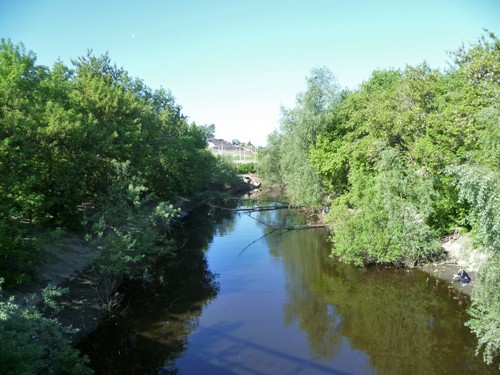
146. Барнаулка недалеко от места впадения в Обь / Barnaulka River near the place of confluence in the Ob
Раннее летнее утро недалеко от устья Барнаулки. Наверное, не так уж много людей вообще знают об этом мостике через реку, с которого и начинается улица Горького. Хотя реконструкция двух других мостов (на проспекте Ленина и на улице Ползунова) наверняка добавила ему известности. Кроме того, стоит отметить немалое количество рыболовов в этом месте - лично я углядел перед съёмкой аж пятерых. То ли и правда здесь рыба неплохо ловится, то ли это просто любимый способ провести субботнее утро.
Early summer morning near the mouth of Barnaulka River. Probably not too many people even know about this bridge across the river, which is the beginning of Gorky's Street. Although the reconstruction of the other two bridges (on the Lenin Avenue and Polzunov's Street) certainly added it some fame. In addition, it is worth noting considerable number of fishermen in this place - personally I noticed before shooting as many as five. Looks like fish bite really nice here, either it's just a favorite way to spend a Saturday morning.
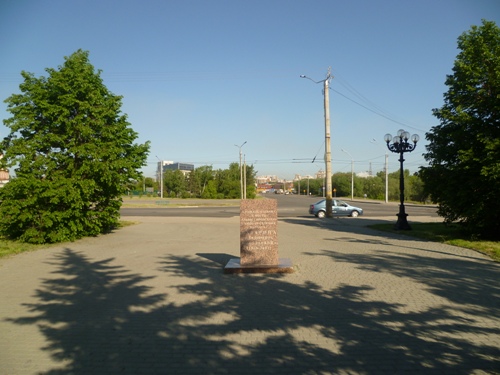
147. Площадь имени В. Н. Баварина / The Bavarin's Square
Безымянная площадь рядом со зданием речного вокзала получила своё нынешнее название в 2003 году после трагической гибели в феврале того же года мэра Барнаула Владимира Николаевича Баварина. Торжественное открытие площади состоялось 6 сентября 2003 года, в процессе открытия площади было освящено место, на котором впоследствии воздвигли часовню Святого равноапостольного князя Владимира. С тех пор сама площадь и окружающая территория всё больше интегрировались в общественную жизнь города, служа площадкой для проведения различных праздничных и иных мероприятий.
Nameless square next to the river station got its current name in 2003 after the tragic death in February of the same year mayor of Barnaul, Vladimir Nikolayevich Bavarin. Solemn opening of the square took place September 6, 2003, in the process of opening the square was consecrated place where later was built the chapel of the Holy Prince Vladimir. Since then, the square itself and the surrounding area more and more integrating into the social life of the town, serving as a venue for various holidays and other events.
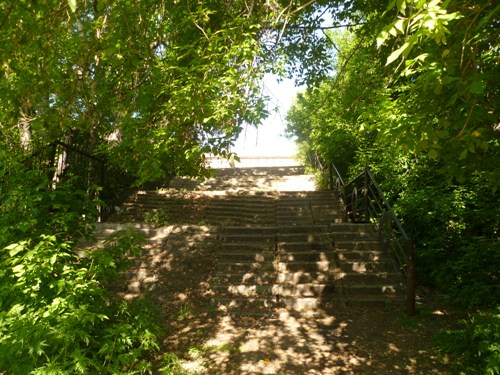
148. Заброшенная лестница рядом с местом, где был старый речной вокзал Барнаула / Abandoned staircase near the site where was the old river station
В 1939-1940 годах на месте одной из речных пристаней Барнаула, в районе небольшого ответвления обского русла, известного в народе как "Ковш", возвели деревянное здание речного вокзала с кассами, буфетом и залом ожидания. Здание со всей окружающей инфраструктурой профункционировало аж до 1985 года, когда было построено новое здание речного вокзала. А после этого и само здание старого вокзала, и вся окрестная территория очень быстро пришли в упадок - и вот эта лестница осталась здесь едва ли не единственным более-менее сохранившимся элементом. Sic transit gloria mundi (Так проходит слава мирская).
In 1939-1940, on the site of one of the river piers of Barnaul, in the vicinity of a small branch of the Ob river bed, known popularly as the "Ladle", was raised a wooden building of a river station with ticket offices, waiting room and buffet. The building with the entire near infrastructure had functioned right up to 1985, when a new building of the river station was built. After that, and old station's building itself, and all surrounding areas very quickly fell into decline - so this ladder remained almost the only more or less preserved element. Sic transit gloria mundi (Thus passes secular glory).

149. Бюст П. П. Семёнова-Тян-Шанского возле одного из корпусов Алтайского государственного университета / Bust of P.P.Semenov-Tian-Shan near one of the buildings of the Altai State University
Этот бюст русскому географу, ботанику и государственному деятелю Петру Петровичу Семёнову-Тян-Шанскому был установлен в 1986 году, одновременно с бюстом Степану Ивановичу Гуляеву и за авторством тех же людей (К.М.Пентешин, А.Л.Богомолец, С.А.Боженко, В.А.Кашин). Собственно, и стоят эти бюсты друг напротив друга. Историческая связь учёного с Барнаулом состоит в том, что именно здесь Семёнов провёл зиму 1856-57 годов, приводя в порядок свои записи о первой экспедиции по исследованию Тянь-Шаня и подготавливая вторую (за эти исследования он и получил приставку к своей фамилии). Если верить историкам, тогда же Семёнов встречался в Барнауле и с известным русским писателем - Фёдором Михайловичем Достоевским.
This bust of the Russian geographer, botanist and statesman Pyotr Petrovich Semenov-Tyan-Shansky was established in 1986, together with the bust of Stepan Ivanovich Gulyaev and was designed by the same people (K. M. Penteshin, A. L. Bogomolets, S. A. Bozhenko, V. A. Kashin). Well, these busts even are facing each other. The historical link of Barnaul with the scientist is that here Semenov spent the winter of 1856-57, sorting his records about the first expedition to study the Tien Shan and preparing the second (exactly for those studies he received an addition to his surname). According to historians, the same time Semenov had meeting in Barnaul with famous Russian writer - Fyodor Dostoevsky.
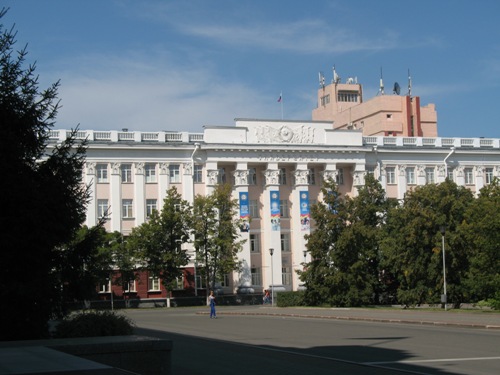
150. Химико-биологический корпус Алтайского государственного университета / Chemical-biological building of Altai State University
Здание корпуса "Л" Алтайского государственного университета было построено в 1958 году, став одним из первых зданий (если не самым первым) архитектурного ансамбля на площади Советов. Первоначально здание находилось в распоряжении Алтайского института сельскохозяйственного машиностроения (впоследствии - Алтайского политехнического института (с 1959), а затем Алтайского государственного технического университета (с 1992)), однако в 1973 году, когда и был основан АГУ, здание передали вновь созданному учебному заведению. Постановлением АКЗС от 28.12.1994 года здание было признано памятником архитектуры регионального значения. А в июле 2006 года здесь случился пожар, в результате которого пострадали крыша, а также третий и четвёртый этажи. Наиболее курьёзным фактом в этой ситуации является то, что пожар возник в ходе проведения работ по реконструкции здания. В итоге проведение реконструкционно-ремонтных работ затянулось до 2007 года. Впрочем, сейчас о случившемся уже давно ничего не напоминает.
The building of housing "L" of the Altai State University was built in 1958, becoming one of the first buildings (if not the first) in the architectural ensemble of the Soviets Square. Originally the building was in the possession of the Altai Institute of Agricultural Engineering (later - the Altai Polytechnic Institute (1959), and then the Altai State Technical University (1992)), but in 1973, when ASU was founded, the building was given to the newly established institution. By decree of ARLA (Altai regional Legislative Assembly) from 28.12.1994, the building was declared a monument of architecture of regional importance. In July 2006 here was a fire, which ended by the damaged roof of the building, as well as the third and fourth floors. The most curious fact in this situation is that fire started in the course of works on reconstruction of the building. As a result, execution of reconstruction and repair works had stretched to 2007. However, now nothing resemble about that incident.
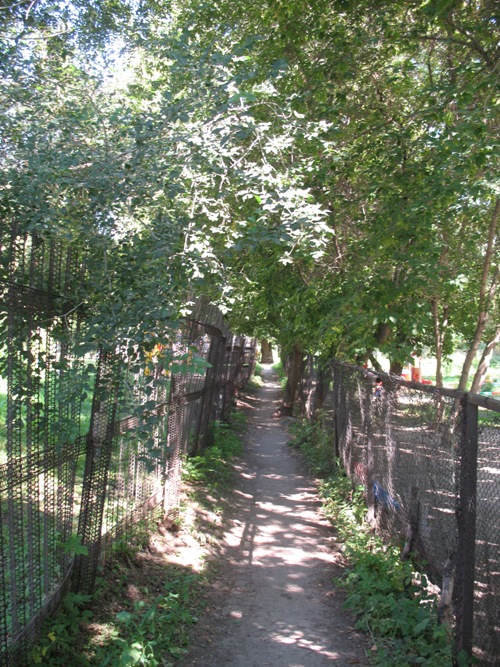
151. Локальные тайные тропы / Local secret trails
"Ах, дворы, дворы...". Сколько в Барнауле (да и в других наших городах) таких мест, которые окрестные жители давно считают торными тропами, а тому, кто туда случайно забредёт или решится отойти от давно заученных маршрутов, открывающих невероятные секреты сокращения расстояний между хорошо знакомыми местами.
"Ah, the yards, the yards ...". How much in Barnaul (and in our other cities) such places, that local residents for long time considers as wide roads, but which for someone who accidentally will come here or will dare to move away from long-memorized routes, will open incredible secrets of reducing distances between familiar places.
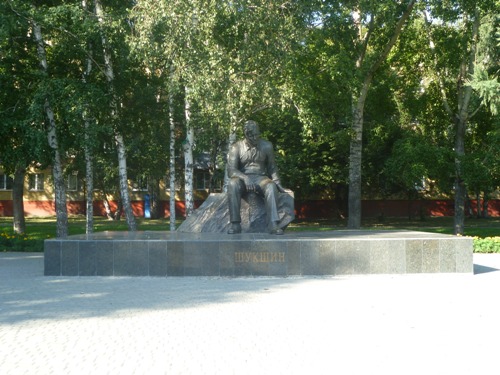
152. Памятник В. М. Шукшину на пересечении улиц Юрина и Шукшина / Monument to V. M. Shukshin at the intersection of Yurin's Street and Shukshin's Street
Наверное, единственным уроженцем алтайской земли, кто может в народных глазах сравниться по масштабу личности с Василием Макаровичем Шукшиным, является Герман Степанович Титов - космонавт №2. Но в плане внешних признаков выражения признания даже он не может конкурировать со сростинским самородком. Наверное, можно сказать, что для Алтайского края Шукшин давно уже стал не просто личностью, а своеобразным явлением. Чего стоят одни только ежегодные "Шукшинские чтения", представляющие собой настоящий культурный праздник, на который регулярно приезжают знаменитости всероссийского уровня. Неудивительно, что "Макарыч" был увековечен и в виде памятника в краевой столице. Памятник этот, за авторством скульпторов Н.В. Звонкова, М.А. Кульгачева, В.Ф. Рублёва и архитектора С.А. Боженко, установили на пересечении улиц Юрина и Шукшина 25 июля 1989 года, к 60-летию со дня рождения писателя, актёра и режиссёра. Подробную историю создания памятника можно узнать из воспоминаний одного из его авторов - Сергея Алексеевича Боженко.
Probably, the only native of the land of Altai region, who can in people's eyes be equal for the personality scale with Vasily Shukshin is German Titov - cosmonaut №2. But in terms of the external signs of demonstration of recognition, even he can not compete with genius from Srostki. Perhaps we can say that Shukshin has already become not just the person for the Altai region, but a kind of phenomenon. Why are only annual "Shukshin's readings", representing themselves a real cultural festival, which is regularly visited by celebrities of russian-wide level. Not surprisingly, "Makarych" was immortalized and as a monument in the regional capital. This monument, authored by sculptors N. V. Zvonkov, M. A. Kulgachev, V. F. Rublev and architect S. A. Bozhenko, was installed at the intersection of Yurin's Street and Shukshin's Street July 25, 1989, the 60th anniversary of the birth of the writer, actor and director. A detailed history of the monument can be found in memoirs of one of its authors - Sergey Alexeevich Bozhenko.
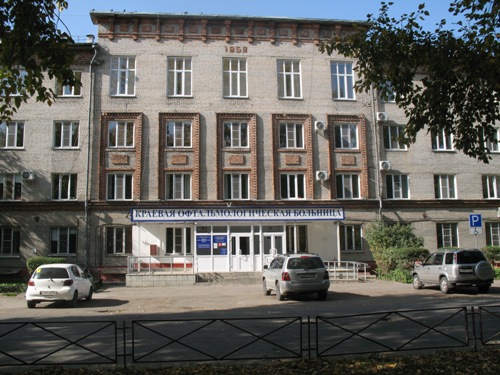
153. Главное здание Алтайской краевой офтальмологической больницы / Main building of Altai regional ophthalmological hospital
Изначально это здание, построенное в 1959 году по проекту Виктора Владимировича Казаринова (и, вероятно, ставшее одним из первых барнаульских строений по его проектам) (ранее в качестве архитектора был ошибочно указан Владимир Леонидович Казаринов, отец Виктора Владимировича), предназначалось для треста "Стройгаз". Однако в 1962-1964 годах его серьёзно перестроили и отдали под госпиталь для инвалидов Отечественной войны (ныне - госпиталь для ветеранов войн). В декабре 1991 года было закончено строительство нового здания госпиталя в нагорной части города, а освободившееся строение передали Алтайской краевой офтальмологической больнице, образованной в ноябре 1991 года путём слияния Алтайской детской краевой офтальмологической больницы и краевого противотрахоматозного диспансера.
Initially, this building, built in 1959 according to the design of Victor Vladimirovich Kazarinov (and, quite possibly, it became one of first buildings in the town by his designs) (earlier, Vladimir Leonidovich Kazarinov, father of Viktor Vladimirovich, was erroneously listed as an architect), was intended for the "Stroygaz" trust. However, in 1962-1964 it was seriously rebuilt and turned into a hospital for disabled veterans of the Patriotic War (now - a hospital for wars veterans). In December 1991, the construction of a new hospital building in the upland part of the town was completed, and the vacated building was transferred to the Altai Regional Ophthalmological Hospital, formed in November 1991 by the merger of the Altai Regional Children's Ophthalmological Hospital and the regional anti-trachomatous dispensary.
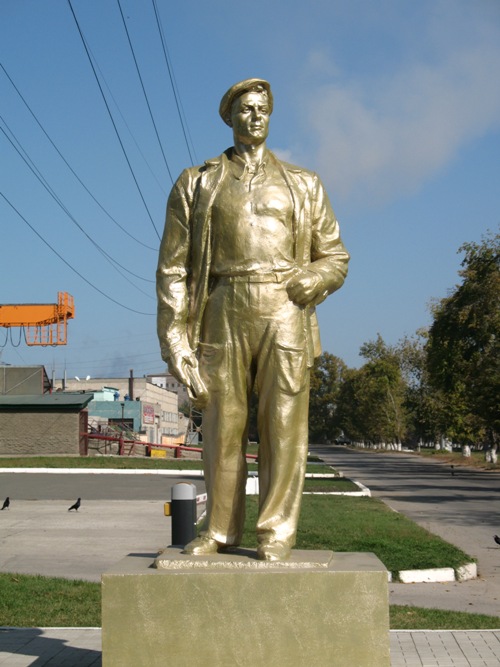
154. "Золотой" рабочий / "Golden" workman
Это - одна из двух скульптур рабочих, восстановленных ко дню города в 2016 году по инициативе руководства ТЭЦ-2. В ходе реконструкционных работ были восстановлены сколотые участки фигур, увеличены размеры постаментов, выложено тротуарной плиткой пространство возле памятников и установлена подсветка.
This is - one of the two sculptures of workers, reconstructed for the Town Day in 2016 at the initiative of the TPS-2 (thermal power station). During the reconstruction had been restored fractured portions of figures, was increased the size of the pedestals, space near the monuments has lined with paving slabs, was installed backlight.
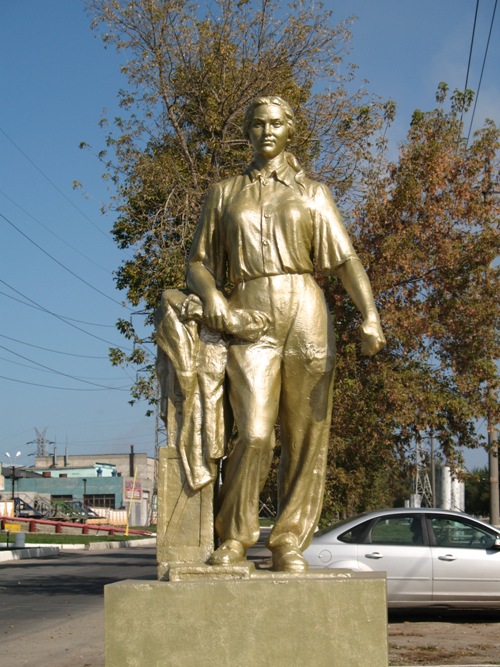
155. "Золотая" рабочая / "Golden" workwoman
Это - одна из двух скульптур рабочих, восстановленных ко дню города в 2016 году по инициативе руководства ТЭЦ-2. Впервые эти гипсовые фигуры были установлены на своих местах ещё в 1970 году, когда по всей стране отмечалось столетие со дня рождения Владимира Ильича Ленина. Тогда ТЭЦ-2 получил сразу 5 подобных памятников рабочим. Два из них были переданы в другую организацию, один установлен возле проходной, а два восстановленных теперь вернулись ко въезду на территории станции со стороны проспекта Калинина.
This is - one of the two sculptures of workers, reconstructed for the Town Day in 2016 at the initiative of the TPS-2 (thermal power station). For the first time, these plaster figures were set in 1970, when the whole country was celebrating the centenary of the birth of Vladimir Ilyich Lenin. Then TPS-2 got as many as 5 monuments of the same type. Two of them were transferred to another organization, one mounted near the entrance, and last two, that was restored, now have come back to the entry to the territory of station from Kalinin's Avenue.
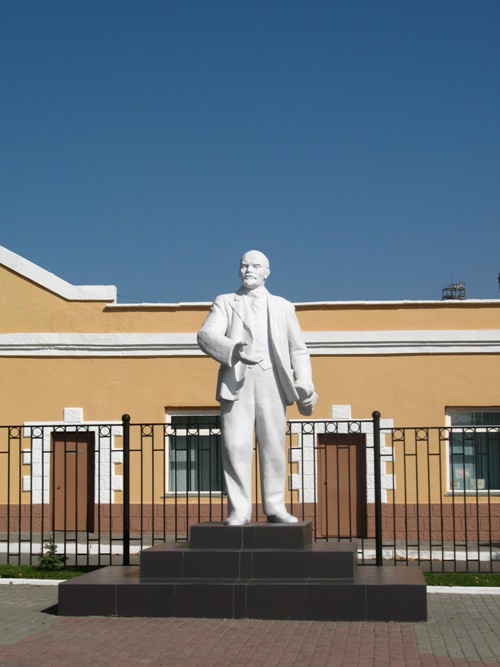
156. Старый памятник на новом месте / Old monument at new place
Из сохранившихся в городе памятников Ленину этот, наверное, имеет самую сложную и мутную историю. Начать с того, что неизвестны имена его авторов - не исключено, что это одна из тех массовых статуй вождя, которые предназначались для установки в парках и тому подобных местах. Однако, в Барнауле в 1956 году этот памятник был водружён на одной из центральных городских площадей - площади Октября. Считается, что он заменил ранее стоявший там памятник Иосифу Сталину, чьи памятники массово демонтировались практически по всей стране после "развенчания культа личности".
С этим памятником связана одна из самых известных городских легенд, которую сейчас уже практически невозможно ни опровергнуть, ни подтвердить. Якобы изначально правая рука вождя мирового пролетариата была прямой и указывала на знаменитый гастроном "Под шпилем". Так что задерживаемые окрест пьяницы отшучивались, дескать, "идём ленинским курсом". А последней каплей, переполнившей чашу терпения городских властей, стала обнаруженная на вытянутой руке авоська с пустыми бутылками. После этого руку у памятника и согнули.
Зато абсолютно точно известно, что в 2012 году широкий резонанс вызвала новость о предстоящем демонтаже памятника в связи с работами по обновлению облика площади Октября. Попытки сохранения памятника на прежнем месте предпринимались, в основном, коммунистическими активистами, однако успеха они не имели. В результате 27 июня 2012 года памятник был демонтирован. Так бы ему и сгинуть, если бы не руководство барнаульского КЖБИ-2, инициировавшего реконструкцию монумента и его установку на территории комбината.
From preserved Lenin monuments in the town this one perhaps has most complex and murky history. Start with the fact that the names of its authors are unknown - it is possible that this is one of those mass statues of the leader, which were intended to be installed in parks and similar locations. However, in Barnaul in 1956, this monument was installed on one of the central urban squares - the October Square. It is believed that it had replaced standing here earlier monument to Joseph Stalin, whose monuments massively were dismantling virtually across the country after the "debunking the cult of personality."
With this monument is connected one of the most famous urban legends, which now almost impossible to deny or confirm. Ostensibly originally right hand of Lenin was straight and pointed to the famous deli "Under the spire." So drunkards, which were being detained in the neighborhood, were joking, that they "go by Leninist course." And the last straw that broke the patience of the city authorities, was a bag with empty bottles, discovered on monument's arm. After that arm was bent."
But absolutely we do know that in 2012 news of the impending dismantling of the monument in connection with the work on updating the look of the October Square caused a wide resonance. Attempts to save the monument in the same place were made, mainly by communist activists, but they were not successful. As a result, June 27, 2012 the monument was dismantled. After that monument could be disappear, if not the directorship of Barnaul CCP-2 (Combine of Concrete Products), which initiated the reconstruction of the monument and its installation on the territory of the combine.
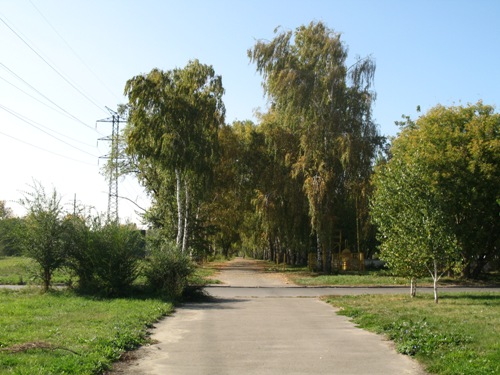
157. Аллея на проспекте Космонавтов / Alley at the Cosmonauts Avenue
Данный участок аллеи на проспекте Космонавтов является, по сути, продолжением заложенного в 1965 году напротив проходной Алтайского моторного завода Парка Победы и Аллеи героев Советского Союза. В 90-х годах, с разрушением большей части индустриальной инфраструктуры и массовым закрытием или глобальным упадком заводов на проспекте, стала приходить в запустение и аллея. К 2016 году ситуация с ней стала совсем печальной: большие заросли травы и кустарника, множество мусора и не самый приятный, как правило, контингент встречающихся лиц. Однако, летом 2016 ситуация начала меняться к лучшему: инициативная группа активистов алтайского отделения КПРФ, кинув клич в народ, организовала и провела ряд субботников, направленных на очистку и приведение в относительный порядок территории парка и части аллеи. Осенью того же года интерес к восстановлению аллеи в качестве общественного пространства для отдыха и прогулок проявила и мэрия города, правда, пока что, в основном, на словах.
This plot of the alley at the Cosmonauts Avenue is, in fact, a continuation of the Alley of Heroes of the Soviet Union and the Victory Park, which was pledged in 1965 in front of the entrance of the Altai Motor Plant. In 90s, with the destruction of much of the industrial infrastructure and the mass closure or global decline of factories at avenue, alley began to fall into desolation too. By 2016, the situation became very sad: big thickets of grass and bushes, a lot of garbage and not the most pleasant, as a rule, contingent of encountered here individuals. However, in the summer of 2016 the situation began to change for the better: the initiative group of activists of the Altai branch of the Communist Party, throwing call to the people, organized and conducted a series of sabbatarians aimed at cleaning and bringing of the relative order at the park and part of the alley's area. In the autumn of the same year, the interest in the restoration of the alley as a public space for recreation and strolls, showed and the town administration, however, basically, in words yet.
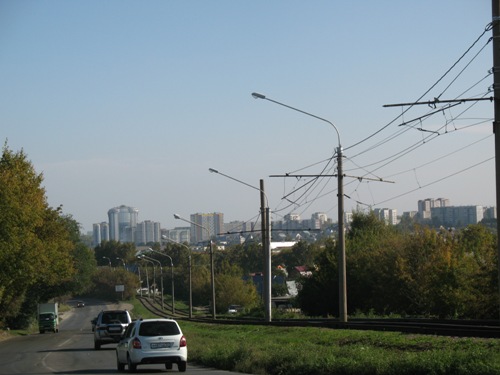
158. Взгляд на город с северо-западной окраины / A look at the city from the north-western outskirts
Пусть и достаточно условно, но Солнечную поляну и проспект Космонавтов вполне можно назвать западной и северной границами города. И вот недалеко от места их пересечения, на своеобразном северо-западном въезде в город, открывается, благодаря особенностям рельефа, неплохая панорама на город, в первую очередь - на относительно новые кварталы с их новостройками. Так что, несмотря на то, что вы ещё находитесь в черте города, создаётся впечатление, что на самом деле вы где-то в ближайшем пригороде, а город зовёт и готовится вас проглотить.
Let rather conditionally, but Solnechnaya Polyana (Sunny Meadow) Street and Cosmonauts Avenue can be called western and northern boundaries of the town. And not so far from the place of their intersection, at a kind of north-western entrance to the town, opens, due to the peculiarities of the relief, a good view of the town, in the first place - to the relatively new quarters with their new buildings. So, despite the fact that you are still in the town, it seems that you are actually somewhere in the suburbs, and the town is calling and preparing to swallow you.


